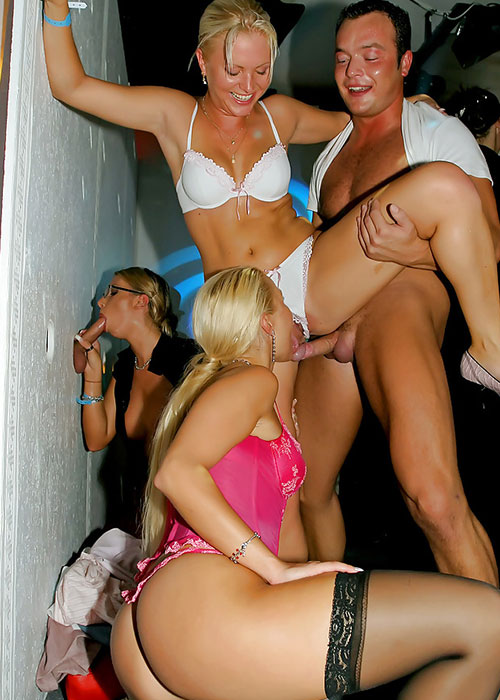The Swinging Lifestyle
Swinging, often colloquially termed as wife swapping, husband swapping, or partner swapping, is a form of non-monogamy where individuals or couples engage in sexual activities with others as a social or recreational endeavor. This practice encompasses a wide array of sexual experiences ranging from mutual masturbation and oral sex to full penetrative intercourse, often occurring between participants who may have varying degrees of acquaintance with one another—from longstanding friends to complete strangers.
Historically, the roots of swinging can be traced back to ancient civilizations, but it's the contemporary evolution of the practice, particularly from the 1960s onward, that captures the focus of current discussion. During this time, swinging emerged from the shadows, paralleling the sexual revolution, and began to be acknowledged as a part of the modern sexual landscape.
From private house parties to sophisticated swingers clubs and dedicated online platforms, swinging has developed its own subculture, characterized by specific codes of conduct and etiquette. It is embraced by some for its ability to add variety, spice up long-term relationships, and provide a platform for exploring sexual freedom within a consensual and often rules-based context.

The sexual revolution of the 1960s was a profound societal shift that dramatically transformed attitudes and behaviors regarding sex and sexuality across the Western world. This period marked a significant departure from the conservative norms of the previous decades, characterized by strict moral codes and limited public discourse on sexual matters.
Several factors contributed to the sexual revolution. The introduction of the birth control pill in 1960 is often cited as a pivotal catalyst. It provided women with unprecedented control over their reproductive health, contributing to a new era of sexual autonomy and liberation. This control over pregnancy risk allowed for a separation of sex from procreation, leading to an increase in premarital sex and open conversations about sexual pleasure.
The 1960s also witnessed the rise of the feminist movement, which challenged traditional gender roles and demanded equal rights for women, including sexual freedom and reproductive rights. There was a growing pushback against the double standards that judged women more harshly for engaging in the same sexual behaviors as men.
Additionally, the decade was marked by the burgeoning of counterculture movements, epitomized by the hippie ethos which advocated for love, peace, and freedom, including sexual expression. The normalization of premarital sex, acceptance of homosexuality, and experimentation with different forms of sexual relationships all gained momentum during this time.
The 1970s continued the trajectory of sexual liberation that had begun in the previous decade, with swinging emerging as a notable component of the era's sexual lifestyle. Often termed the "Swinging Seventies," this period saw a more mainstream acknowledgment and participation in non-monogamous sexual activities, including swinging.
The swinging scene of the 70s, with its parties and lifestyle components, represented an apex of the sexual revolution, reflecting a society in the midst of redefining intimacy, pleasure, and the boundaries of traditional relationships. Swinging was part of a larger movement that questioned societal norms, although it was not without its critics who pointed to potential emotional complexities and risks.
It's important to note that while swinging became more visible and accepted during this time, it still remained somewhat subcultural and not fully embraced by mainstream society. Nevertheless, the 70s played a critical role in the evolution of modern sexual freedom and the diverse expressions of intimacy we see today.

People engage in swinging for a variety of reasons, and their motivations can be as diverse as the individuals themselves. Here are some common reasons why people may choose to participate in swinging:
Sexual Exploration:
Many are drawn to swinging as a way to explore their sexuality in a safe and consensual environment. It allows individuals and couples to experience different partners, participate in group sex, or explore bisexual or homosexual encounters they might not have otherwise had.
Variety and Excitement:
For some, the appeal of swinging lies in the novelty and the excitement of being with someone new. This can bring a different dynamic to one's sex life and can be a thrilling experience for those involved.
Enhancing the Primary Relationship:
Some couples find that swinging brings a new level of openness and honesty to their relationship. It can increase communication and can rekindle the passion within their primary partnership by breaking the routine.
Fulfilling Fantasies:
Swinging can be a way to fulfill sexual fantasies that involve multiple partners, without the complications that might arise from an affair or infidelity in a monogamous relationship.
Community and Friendship:
The swinging community often provides a sense of camaraderie and friendship. People enjoy the social aspect of swinging as much as the sexual, forming close-knit networks with like-minded individuals.
No-Strings-Attached Sex:
Swinging allows individuals to engage in sexual activity without the expectation of a romantic relationship or emotional attachment. It's understood that the interactions are recreational.
Personal Autonomy and Empowerment:
Some people participate in swinging as a statement of personal freedom and autonomy. It can be empowering to take control of one's sexual desires and engage in consensual activities that society may otherwise stigmatize.
Avoiding Infidelity:
Couples might turn to swinging as a way to avoid the secrecy and betrayal of infidelity. Swinging provides a framework where such activities are not only allowed but also done openly and with consent from one's partner.
Building Trust:
For some couples, swinging can strengthen trust. Engaging in sexual activities with others openly and with consent can solidify the trust between partners in the primary relationship.
It's worth noting that while swinging can have many positive aspects for those who choose to engage in it, it's not for everyone and can lead to complications if not approached with clear boundaries, good communication, and mutual consent. For swinging to be a positive experience, all parties involved must be comfortable with the arrangement and able to manage any emotions, like jealousy, that may arise.
Swinging within the porn industry can be both a portrayed fantasy and a lifestyle choice for those involved in adult entertainment. Within the context of adult films, swinging is often depicted to cater to the fantasies of viewers who are intrigued by the idea of engaging in sexual activities with multiple partners, partner swapping, or group sex scenarios.

In adult films, swinging scenes are choreographed to showcase a variety of sexual activities among multiple participants, emphasizing the liberating and hedonistic aspects of the lifestyle. The portrayal of swinging in pornography often idealizes the experience, focusing on the physical pleasure and excitement without necessarily representing the emotional complexities or the necessity of consent, communication, and boundary-setting that are crucial in real-life swinging encounters.
As for those who work in the adult entertainment industry, swinging might be part of their personal lives, just as it is for some outside the industry. Performers, producers, and crew members may engage in swinging activities privately, enjoying the community and the sexual freedom it provides. The porn industry can have its own subculture of swinging, with adult film stars hosting or attending private parties and events where consensual non-monogamous activities take place among willing participants.
It's also common for adult entertainment professionals to be invited to swingers' events and conventions as guests or performers due to their celebrity status within the community. Their presence can be a draw for attendees who are fans of their work and who appreciate the opportunity to mingle with personalities from the porn industry.
However, it's crucial to distinguish between the on-screen depiction of swinging in pornographic material and the real-life practice among consenting adults. In the porn industry, as in all media, swinging is a performance designed for an audience, whereas real-life swinging requires mutual consent, respect, and understanding among all parties involved. In both cases, safety measures, including regular testing for sexually transmitted infections (STIs) and the use of protection, are important considerations to maintain the health and well-being of those participating.

Swinging, in the modern context, is a component of what is often referred to as the lifestyle or "the Lifestyle," which encompasses a variety of practices involving consensual non-monogamy. Today's swinging scene is characterized by a greater level of openness and acceptance than in the past, facilitated by the internet, which provides resources, community forums, and dating sites specifically catering to swingers.
To help with exploring this genre of porn, we have some swingers deals available such as ReifeSwinger discount and RealTampaSwingers discount. Both of them can be purchased from our website.
Modern swinging encompasses a wide spectrum of activities from soft swap (engaging in sexual activities with someone else but not full intercourse) to full swap (including intercourse), and can occur in private or at public events like clubs and parties. The practice encourages sexual exploration in a consensual and non-monogamous setting, where couples can engage with others for sexual pleasure while maintaining their primary emotional relationship.
Several areas around the world are known for their active swinging communities and destinations:
Europe:
Countries like the Netherlands, Germany, and France have a well-established swinging scene, with numerous clubs and resorts catering to lifestyle participants. Cities like Amsterdam, Berlin, and Paris are known for their liberal attitudes towards sex and have become meccas for swingers.
USA:
In the United States, there are many states where swinging is popular, with California, Florida, and Nevada being notable for their swinging communities and events. Las Vegas, Miami, and Los Angeles are often highlighted for their adult-only events, private parties, and clubs.
Online Spaces:
The internet has been instrumental in expanding the swinging community by creating a virtual space for people to meet, exchange experiences, and arrange meet-ups. It's also a vital tool for newcomers to learn about swinging etiquette and safety.
Swingers often attend organized events such as hotel takeovers, cruises, or resort vacations that are specifically designed for those in the Lifestyle. These events and venues provide a safe and controlled environment where swingers can explore their sexuality with like-minded individuals.
Despite being more recognized and accepted, swinging still faces stigma and misconceptions, and as such, discretion remains a key component of the Lifestyle. Those who participate often maintain anonymity to avoid personal or professional backlash.
Safety and consent are paramount within the swinging community. Regular STI screenings, use of protection, and clear communication about boundaries and rules are essential practices. Swinging is built on trust and mutual respect, with the understanding that anyone can withdraw consent at any time.
As societies evolve and become more accepting of various forms of sexual expression, swinging continues to grow in popularity, offering a way for consenting adults to explore their sexuality in a non-traditional yet controlled environment.
The upside-down pineapple is a playful and somewhat covert symbol that has come to be associated with the swinging community. This quirky emblem has its roots in hospitality—the pineapple itself is a traditional symbol of welcome, friendship, and hospitality, resonating with the idea of opening one's home to others. When turned upside down, it takes on a new, coded meaning, signaling that someone is interested in swinging.
The usage of the upside-down pineapple is most common among those in the swinging lifestyle as a subtle indicator to others in the know. It can be seen on clothing, accessories, or even as a decoration outside a house or in a shopping cart at a grocery store. The key to the symbol is its placement; an upside-down pineapple in an unexpected context is what creates the signal for those who recognize its significance.

In essence, it's a modern-day secret handshake—a way for swingers to identify each other without exposing themselves to potential judgment or stigma from those outside their community. It allows individuals and couples who are open to non-monogamous sexual experiences with others to put out feelers in a discreet manner.
While the upside-down pineapple is not universally recognized and can be used innocently by those who are unaware of its alternate meaning, within the Lifestyle it serves as a playful nod to like-minded people. This symbol represents a fascinating example of how subcultures develop their own signs and language to communicate in plain sight, yet under the radar of mainstream awareness.
Swingers might use the upside-down pineapple while on vacation, on bumper stickers, in online profiles, or even in social media postings to signal their involvement in the Lifestyle. However, as the symbol has become more widely discussed, the effectiveness of its discretion may diminish, but for now, it remains a fun and cryptic symbol for those in the swinging community.
The future of swinging appears poised for continued evolution, shaped by broader social attitudes, technology, and changing cultural norms. As society becomes more accepting of diverse relationship structures, swinging may gain mainstream recognition, reducing stigma and encouraging open dialogue about consensual non-monogamy.
Technological advancements, such as secure and user-friendly apps and platforms, are likely to facilitate connections within the swinging community, making it easier for interested individuals to find like-minded partners and safe spaces for exploration. Virtual reality could offer new, immersive experiences that might expand the boundaries of the lifestyle.
A lot of other porn discounts can also be found here, you just have to explore our website and we fell confident that you are going to find deals to your liking.
Swinging could see a more diverse demographic as younger generations, who tend to have more liberal views on sexual exploration, reach adulthood. This could lead to a redefinition of swinging, potentially blending it with other forms of non-traditional relationships, and influencing how it is practiced and perceived in the future.
